Advanced Remuneration and Performance Management: A Case Study
VerifiedAdded on 2021/06/17
|12
|2733
|119
Report
AI Summary
This report provides a comprehensive analysis of remuneration and performance management systems, focusing on a case study of O'Meara Electronics. It begins by defining remuneration and its importance, highlighting the lack of a universally efficient system. The report then delves into a detailed comparison of position-based and person-based remuneration systems, outlining the advantages and disadvantages of each. The position-based system is examined for its fairness, clarity in pay progression, and ease of administration. In contrast, the person-based system, or competency-based pay, is explored for its motivational aspects, its ability to foster self-improvement, and its positive impact on staff retention. The report concludes by recommending a person or competency-based remuneration system for O'Meara Electronics, with a proposed implementation plan and evaluation process. The study emphasizes the importance of aligning remuneration with individual and organizational performance to achieve success.

Running head: ADVANCED REMUNERATION AND PERFORMANCE MANAGEMENT
Advanced Remuneration and Performance Management
Name of the Student:
Name of the University:
Author Note:
Advanced Remuneration and Performance Management
Name of the Student:
Name of the University:
Author Note:
Paraphrase This Document
Need a fresh take? Get an instant paraphrase of this document with our AI Paraphraser
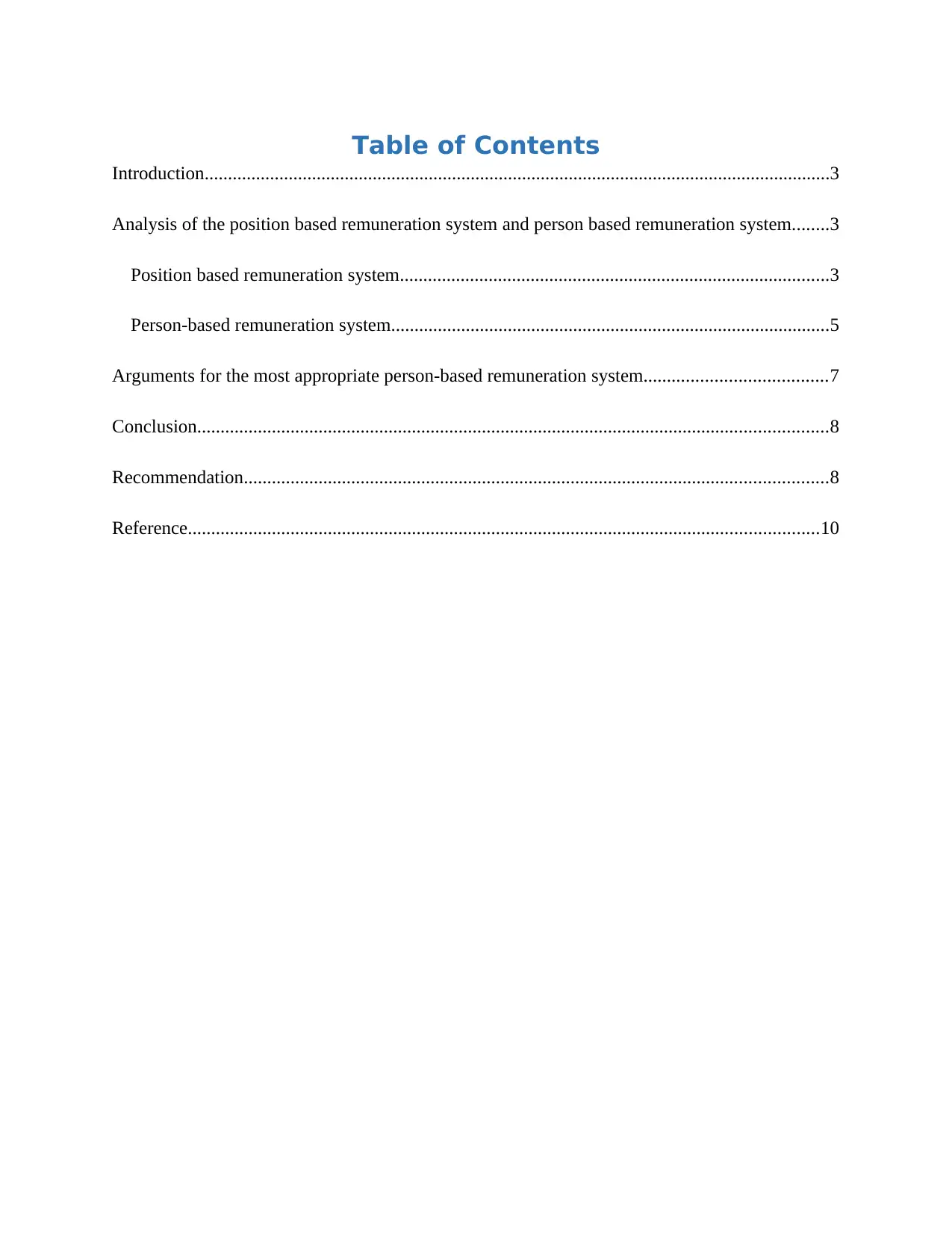
Table of Contents
Introduction......................................................................................................................................3
Analysis of the position based remuneration system and person based remuneration system........3
Position based remuneration system............................................................................................3
Person-based remuneration system..............................................................................................5
Arguments for the most appropriate person-based remuneration system.......................................7
Conclusion.......................................................................................................................................8
Recommendation.............................................................................................................................8
Reference.......................................................................................................................................10
Introduction......................................................................................................................................3
Analysis of the position based remuneration system and person based remuneration system........3
Position based remuneration system............................................................................................3
Person-based remuneration system..............................................................................................5
Arguments for the most appropriate person-based remuneration system.......................................7
Conclusion.......................................................................................................................................8
Recommendation.............................................................................................................................8
Reference.......................................................................................................................................10
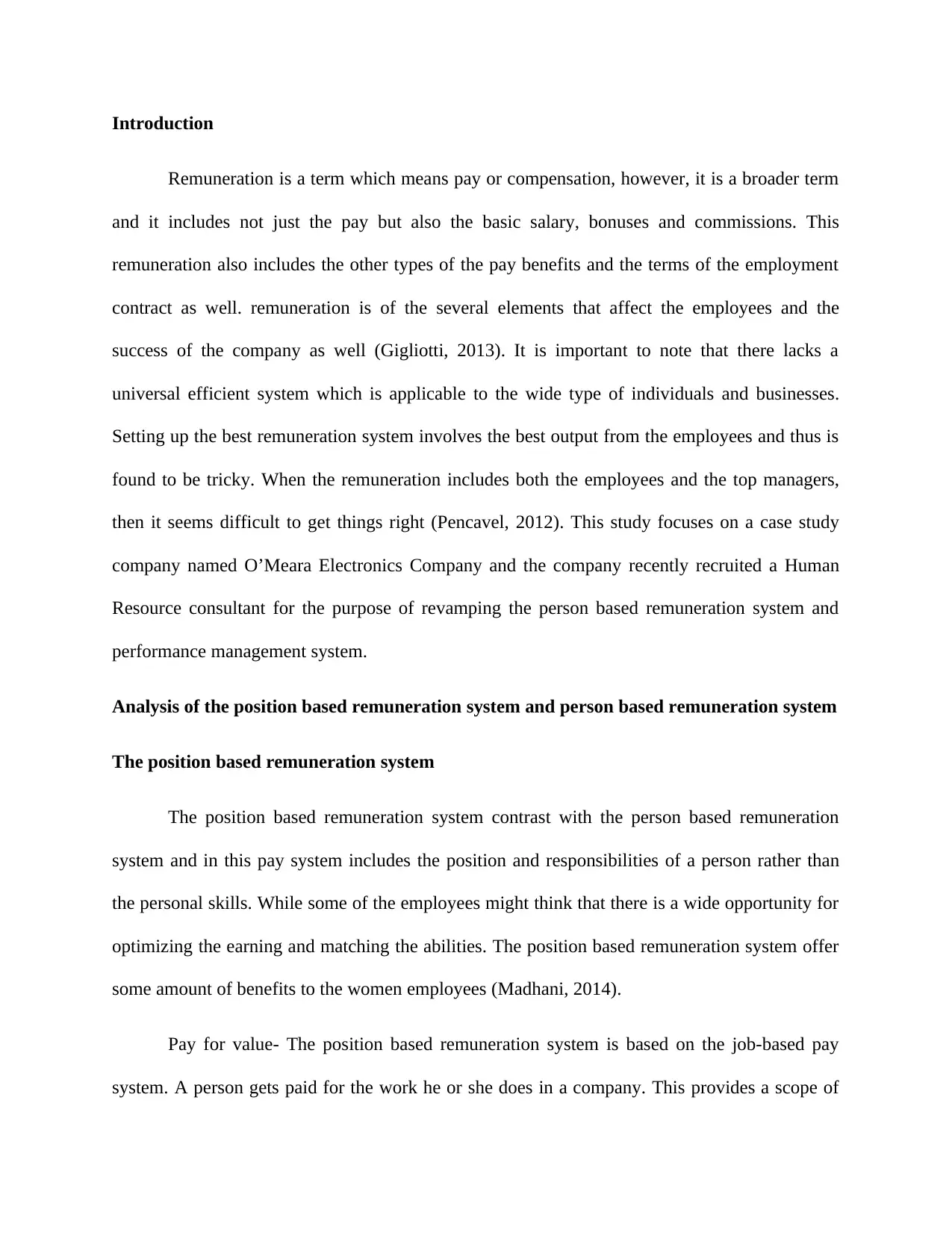
Introduction
Remuneration is a term which means pay or compensation, however, it is a broader term
and it includes not just the pay but also the basic salary, bonuses and commissions. This
remuneration also includes the other types of the pay benefits and the terms of the employment
contract as well. remuneration is of the several elements that affect the employees and the
success of the company as well (Gigliotti, 2013). It is important to note that there lacks a
universal efficient system which is applicable to the wide type of individuals and businesses.
Setting up the best remuneration system involves the best output from the employees and thus is
found to be tricky. When the remuneration includes both the employees and the top managers,
then it seems difficult to get things right (Pencavel, 2012). This study focuses on a case study
company named O’Meara Electronics Company and the company recently recruited a Human
Resource consultant for the purpose of revamping the person based remuneration system and
performance management system.
Analysis of the position based remuneration system and person based remuneration system
The position based remuneration system
The position based remuneration system contrast with the person based remuneration
system and in this pay system includes the position and responsibilities of a person rather than
the personal skills. While some of the employees might think that there is a wide opportunity for
optimizing the earning and matching the abilities. The position based remuneration system offer
some amount of benefits to the women employees (Madhani, 2014).
Pay for value- The position based remuneration system is based on the job-based pay
system. A person gets paid for the work he or she does in a company. This provides a scope of
Remuneration is a term which means pay or compensation, however, it is a broader term
and it includes not just the pay but also the basic salary, bonuses and commissions. This
remuneration also includes the other types of the pay benefits and the terms of the employment
contract as well. remuneration is of the several elements that affect the employees and the
success of the company as well (Gigliotti, 2013). It is important to note that there lacks a
universal efficient system which is applicable to the wide type of individuals and businesses.
Setting up the best remuneration system involves the best output from the employees and thus is
found to be tricky. When the remuneration includes both the employees and the top managers,
then it seems difficult to get things right (Pencavel, 2012). This study focuses on a case study
company named O’Meara Electronics Company and the company recently recruited a Human
Resource consultant for the purpose of revamping the person based remuneration system and
performance management system.
Analysis of the position based remuneration system and person based remuneration system
The position based remuneration system
The position based remuneration system contrast with the person based remuneration
system and in this pay system includes the position and responsibilities of a person rather than
the personal skills. While some of the employees might think that there is a wide opportunity for
optimizing the earning and matching the abilities. The position based remuneration system offer
some amount of benefits to the women employees (Madhani, 2014).
Pay for value- The position based remuneration system is based on the job-based pay
system. A person gets paid for the work he or she does in a company. This provides a scope of
⊘ This is a preview!⊘
Do you want full access?
Subscribe today to unlock all pages.

Trusted by 1+ million students worldwide
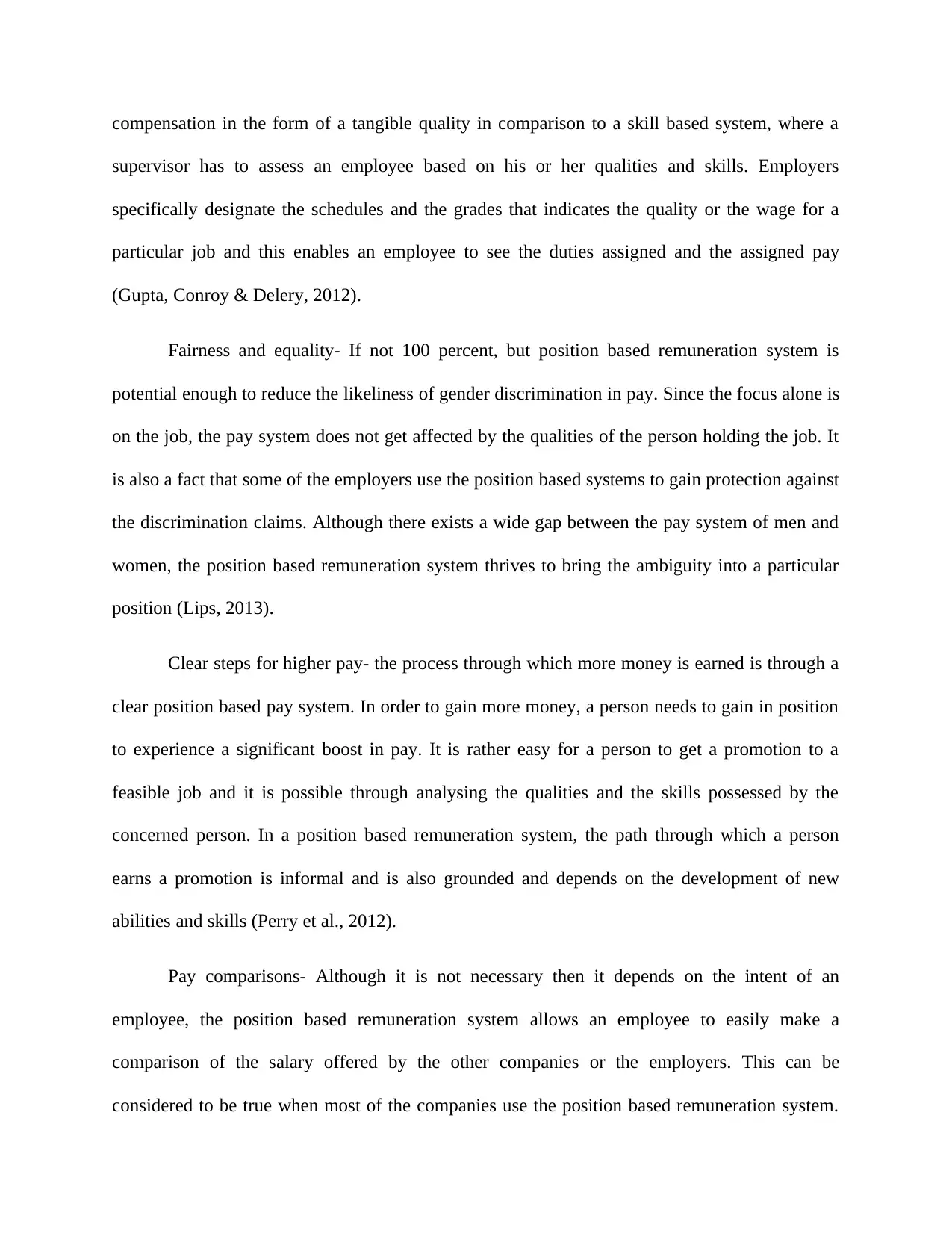
compensation in the form of a tangible quality in comparison to a skill based system, where a
supervisor has to assess an employee based on his or her qualities and skills. Employers
specifically designate the schedules and the grades that indicates the quality or the wage for a
particular job and this enables an employee to see the duties assigned and the assigned pay
(Gupta, Conroy & Delery, 2012).
Fairness and equality- If not 100 percent, but position based remuneration system is
potential enough to reduce the likeliness of gender discrimination in pay. Since the focus alone is
on the job, the pay system does not get affected by the qualities of the person holding the job. It
is also a fact that some of the employers use the position based systems to gain protection against
the discrimination claims. Although there exists a wide gap between the pay system of men and
women, the position based remuneration system thrives to bring the ambiguity into a particular
position (Lips, 2013).
Clear steps for higher pay- the process through which more money is earned is through a
clear position based pay system. In order to gain more money, a person needs to gain in position
to experience a significant boost in pay. It is rather easy for a person to get a promotion to a
feasible job and it is possible through analysing the qualities and the skills possessed by the
concerned person. In a position based remuneration system, the path through which a person
earns a promotion is informal and is also grounded and depends on the development of new
abilities and skills (Perry et al., 2012).
Pay comparisons- Although it is not necessary then it depends on the intent of an
employee, the position based remuneration system allows an employee to easily make a
comparison of the salary offered by the other companies or the employers. This can be
considered to be true when most of the companies use the position based remuneration system.
supervisor has to assess an employee based on his or her qualities and skills. Employers
specifically designate the schedules and the grades that indicates the quality or the wage for a
particular job and this enables an employee to see the duties assigned and the assigned pay
(Gupta, Conroy & Delery, 2012).
Fairness and equality- If not 100 percent, but position based remuneration system is
potential enough to reduce the likeliness of gender discrimination in pay. Since the focus alone is
on the job, the pay system does not get affected by the qualities of the person holding the job. It
is also a fact that some of the employers use the position based systems to gain protection against
the discrimination claims. Although there exists a wide gap between the pay system of men and
women, the position based remuneration system thrives to bring the ambiguity into a particular
position (Lips, 2013).
Clear steps for higher pay- the process through which more money is earned is through a
clear position based pay system. In order to gain more money, a person needs to gain in position
to experience a significant boost in pay. It is rather easy for a person to get a promotion to a
feasible job and it is possible through analysing the qualities and the skills possessed by the
concerned person. In a position based remuneration system, the path through which a person
earns a promotion is informal and is also grounded and depends on the development of new
abilities and skills (Perry et al., 2012).
Pay comparisons- Although it is not necessary then it depends on the intent of an
employee, the position based remuneration system allows an employee to easily make a
comparison of the salary offered by the other companies or the employers. This can be
considered to be true when most of the companies use the position based remuneration system.
Paraphrase This Document
Need a fresh take? Get an instant paraphrase of this document with our AI Paraphraser
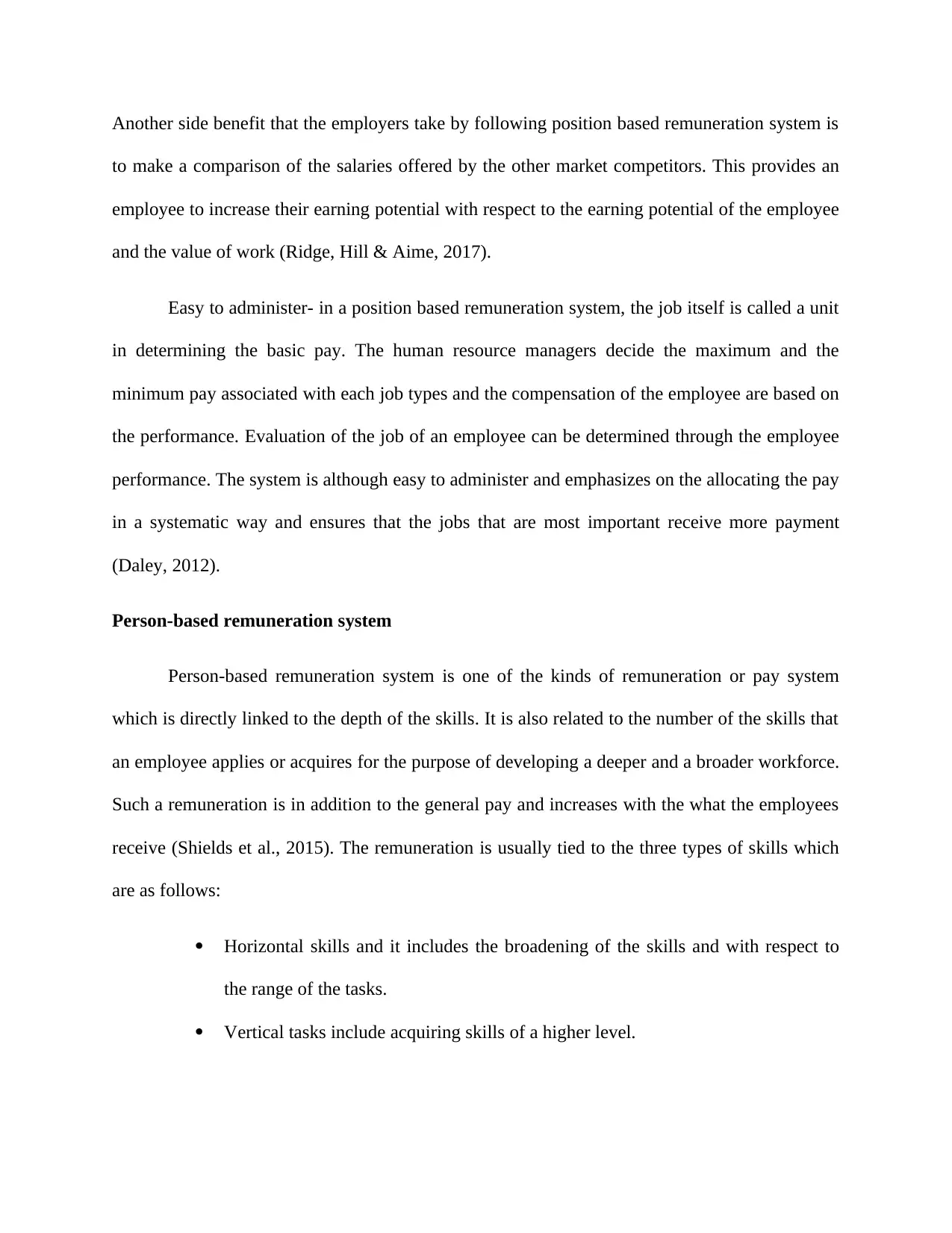
Another side benefit that the employers take by following position based remuneration system is
to make a comparison of the salaries offered by the other market competitors. This provides an
employee to increase their earning potential with respect to the earning potential of the employee
and the value of work (Ridge, Hill & Aime, 2017).
Easy to administer- in a position based remuneration system, the job itself is called a unit
in determining the basic pay. The human resource managers decide the maximum and the
minimum pay associated with each job types and the compensation of the employee are based on
the performance. Evaluation of the job of an employee can be determined through the employee
performance. The system is although easy to administer and emphasizes on the allocating the pay
in a systematic way and ensures that the jobs that are most important receive more payment
(Daley, 2012).
Person-based remuneration system
Person-based remuneration system is one of the kinds of remuneration or pay system
which is directly linked to the depth of the skills. It is also related to the number of the skills that
an employee applies or acquires for the purpose of developing a deeper and a broader workforce.
Such a remuneration is in addition to the general pay and increases with the what the employees
receive (Shields et al., 2015). The remuneration is usually tied to the three types of skills which
are as follows:
Horizontal skills and it includes the broadening of the skills and with respect to
the range of the tasks.
Vertical tasks include acquiring skills of a higher level.
to make a comparison of the salaries offered by the other market competitors. This provides an
employee to increase their earning potential with respect to the earning potential of the employee
and the value of work (Ridge, Hill & Aime, 2017).
Easy to administer- in a position based remuneration system, the job itself is called a unit
in determining the basic pay. The human resource managers decide the maximum and the
minimum pay associated with each job types and the compensation of the employee are based on
the performance. Evaluation of the job of an employee can be determined through the employee
performance. The system is although easy to administer and emphasizes on the allocating the pay
in a systematic way and ensures that the jobs that are most important receive more payment
(Daley, 2012).
Person-based remuneration system
Person-based remuneration system is one of the kinds of remuneration or pay system
which is directly linked to the depth of the skills. It is also related to the number of the skills that
an employee applies or acquires for the purpose of developing a deeper and a broader workforce.
Such a remuneration is in addition to the general pay and increases with the what the employees
receive (Shields et al., 2015). The remuneration is usually tied to the three types of skills which
are as follows:
Horizontal skills and it includes the broadening of the skills and with respect to
the range of the tasks.
Vertical tasks include acquiring skills of a higher level.
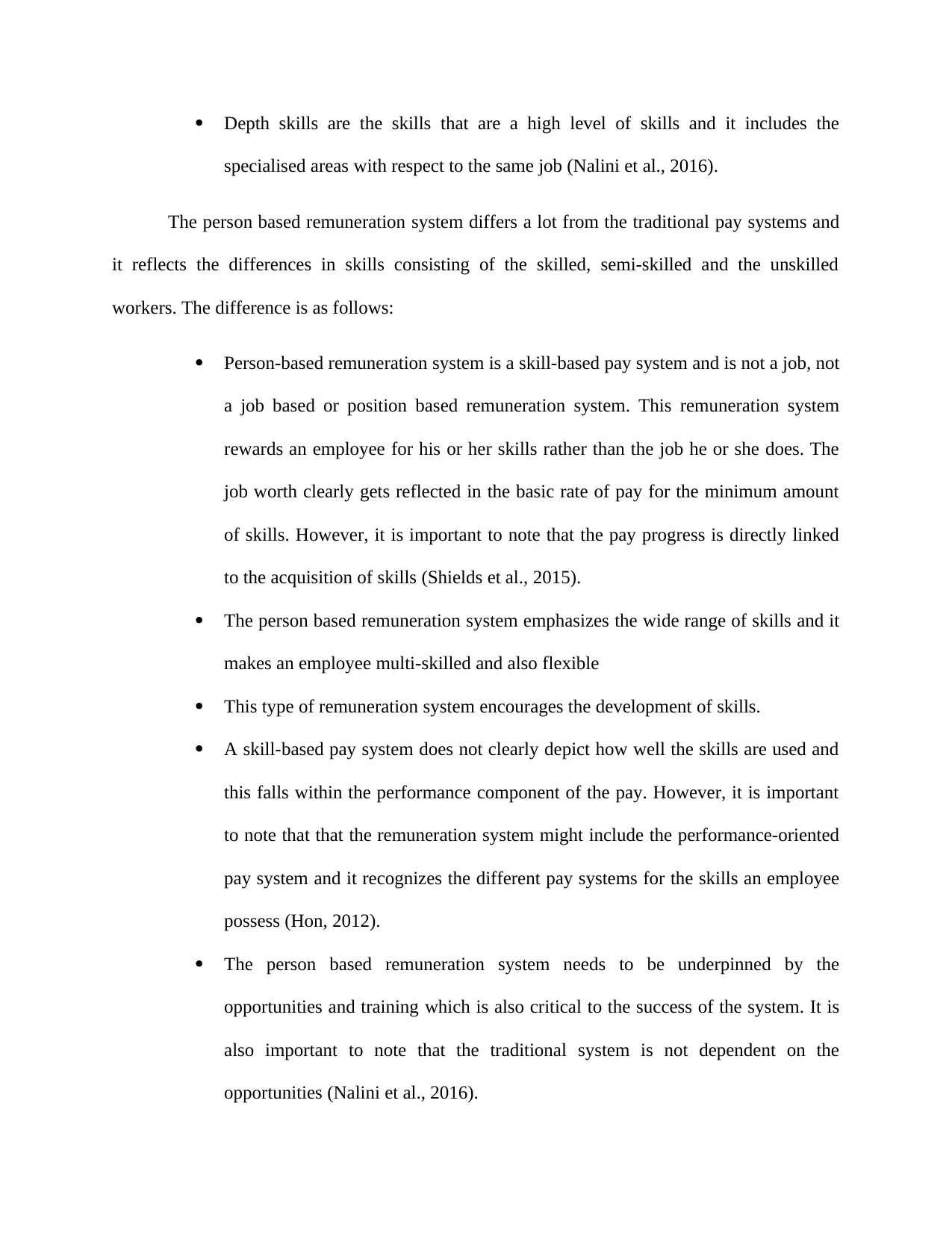
Depth skills are the skills that are a high level of skills and it includes the
specialised areas with respect to the same job (Nalini et al., 2016).
The person based remuneration system differs a lot from the traditional pay systems and
it reflects the differences in skills consisting of the skilled, semi-skilled and the unskilled
workers. The difference is as follows:
Person-based remuneration system is a skill-based pay system and is not a job, not
a job based or position based remuneration system. This remuneration system
rewards an employee for his or her skills rather than the job he or she does. The
job worth clearly gets reflected in the basic rate of pay for the minimum amount
of skills. However, it is important to note that the pay progress is directly linked
to the acquisition of skills (Shields et al., 2015).
The person based remuneration system emphasizes the wide range of skills and it
makes an employee multi-skilled and also flexible
This type of remuneration system encourages the development of skills.
A skill-based pay system does not clearly depict how well the skills are used and
this falls within the performance component of the pay. However, it is important
to note that that the remuneration system might include the performance-oriented
pay system and it recognizes the different pay systems for the skills an employee
possess (Hon, 2012).
The person based remuneration system needs to be underpinned by the
opportunities and training which is also critical to the success of the system. It is
also important to note that the traditional system is not dependent on the
opportunities (Nalini et al., 2016).
specialised areas with respect to the same job (Nalini et al., 2016).
The person based remuneration system differs a lot from the traditional pay systems and
it reflects the differences in skills consisting of the skilled, semi-skilled and the unskilled
workers. The difference is as follows:
Person-based remuneration system is a skill-based pay system and is not a job, not
a job based or position based remuneration system. This remuneration system
rewards an employee for his or her skills rather than the job he or she does. The
job worth clearly gets reflected in the basic rate of pay for the minimum amount
of skills. However, it is important to note that the pay progress is directly linked
to the acquisition of skills (Shields et al., 2015).
The person based remuneration system emphasizes the wide range of skills and it
makes an employee multi-skilled and also flexible
This type of remuneration system encourages the development of skills.
A skill-based pay system does not clearly depict how well the skills are used and
this falls within the performance component of the pay. However, it is important
to note that that the remuneration system might include the performance-oriented
pay system and it recognizes the different pay systems for the skills an employee
possess (Hon, 2012).
The person based remuneration system needs to be underpinned by the
opportunities and training which is also critical to the success of the system. It is
also important to note that the traditional system is not dependent on the
opportunities (Nalini et al., 2016).
⊘ This is a preview!⊘
Do you want full access?
Subscribe today to unlock all pages.

Trusted by 1+ million students worldwide
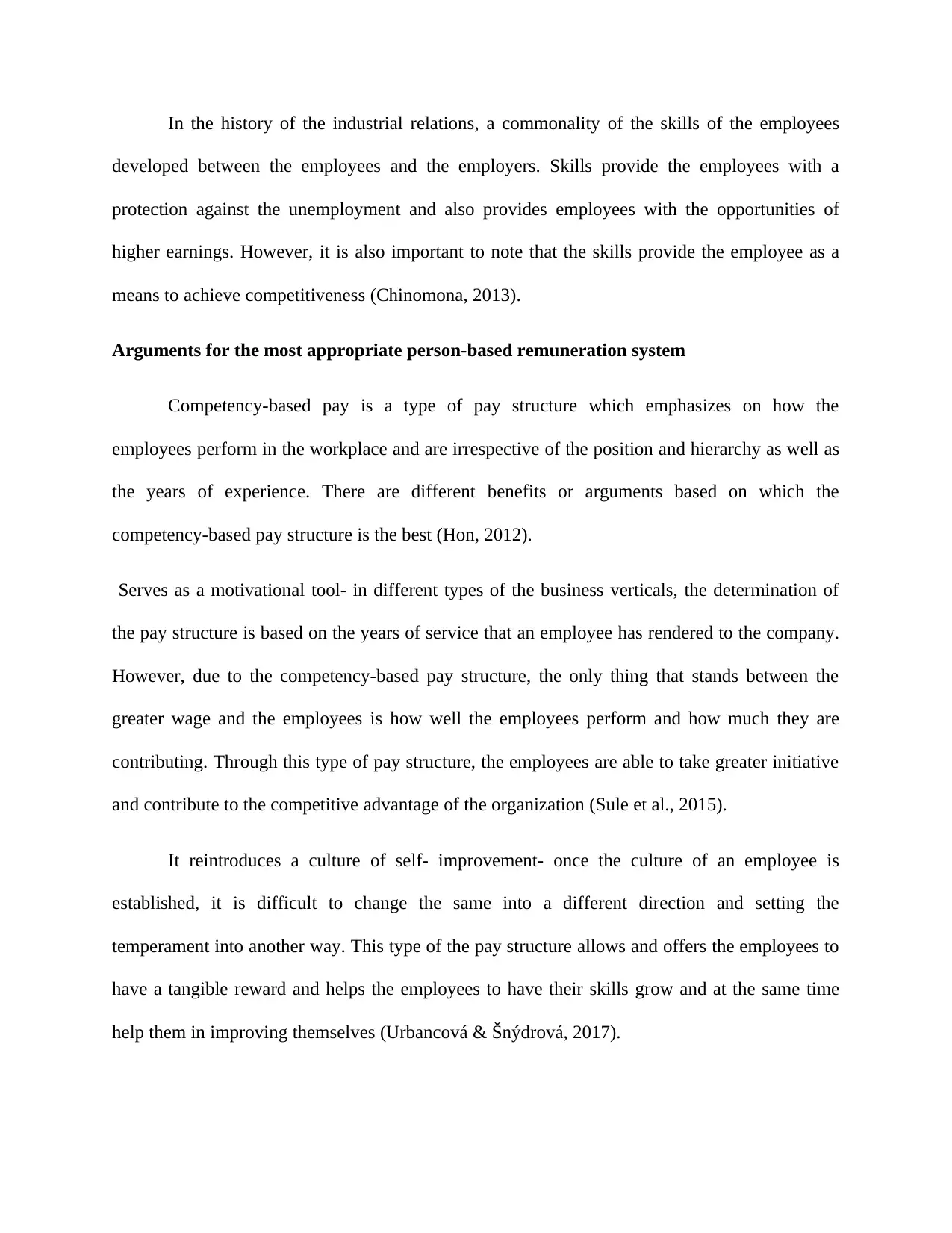
In the history of the industrial relations, a commonality of the skills of the employees
developed between the employees and the employers. Skills provide the employees with a
protection against the unemployment and also provides employees with the opportunities of
higher earnings. However, it is also important to note that the skills provide the employee as a
means to achieve competitiveness (Chinomona, 2013).
Arguments for the most appropriate person-based remuneration system
Competency-based pay is a type of pay structure which emphasizes on how the
employees perform in the workplace and are irrespective of the position and hierarchy as well as
the years of experience. There are different benefits or arguments based on which the
competency-based pay structure is the best (Hon, 2012).
Serves as a motivational tool- in different types of the business verticals, the determination of
the pay structure is based on the years of service that an employee has rendered to the company.
However, due to the competency-based pay structure, the only thing that stands between the
greater wage and the employees is how well the employees perform and how much they are
contributing. Through this type of pay structure, the employees are able to take greater initiative
and contribute to the competitive advantage of the organization (Sule et al., 2015).
It reintroduces a culture of self- improvement- once the culture of an employee is
established, it is difficult to change the same into a different direction and setting the
temperament into another way. This type of the pay structure allows and offers the employees to
have a tangible reward and helps the employees to have their skills grow and at the same time
help them in improving themselves (Urbancová & Šnýdrová, 2017).
developed between the employees and the employers. Skills provide the employees with a
protection against the unemployment and also provides employees with the opportunities of
higher earnings. However, it is also important to note that the skills provide the employee as a
means to achieve competitiveness (Chinomona, 2013).
Arguments for the most appropriate person-based remuneration system
Competency-based pay is a type of pay structure which emphasizes on how the
employees perform in the workplace and are irrespective of the position and hierarchy as well as
the years of experience. There are different benefits or arguments based on which the
competency-based pay structure is the best (Hon, 2012).
Serves as a motivational tool- in different types of the business verticals, the determination of
the pay structure is based on the years of service that an employee has rendered to the company.
However, due to the competency-based pay structure, the only thing that stands between the
greater wage and the employees is how well the employees perform and how much they are
contributing. Through this type of pay structure, the employees are able to take greater initiative
and contribute to the competitive advantage of the organization (Sule et al., 2015).
It reintroduces a culture of self- improvement- once the culture of an employee is
established, it is difficult to change the same into a different direction and setting the
temperament into another way. This type of the pay structure allows and offers the employees to
have a tangible reward and helps the employees to have their skills grow and at the same time
help them in improving themselves (Urbancová & Šnýdrová, 2017).
Paraphrase This Document
Need a fresh take? Get an instant paraphrase of this document with our AI Paraphraser
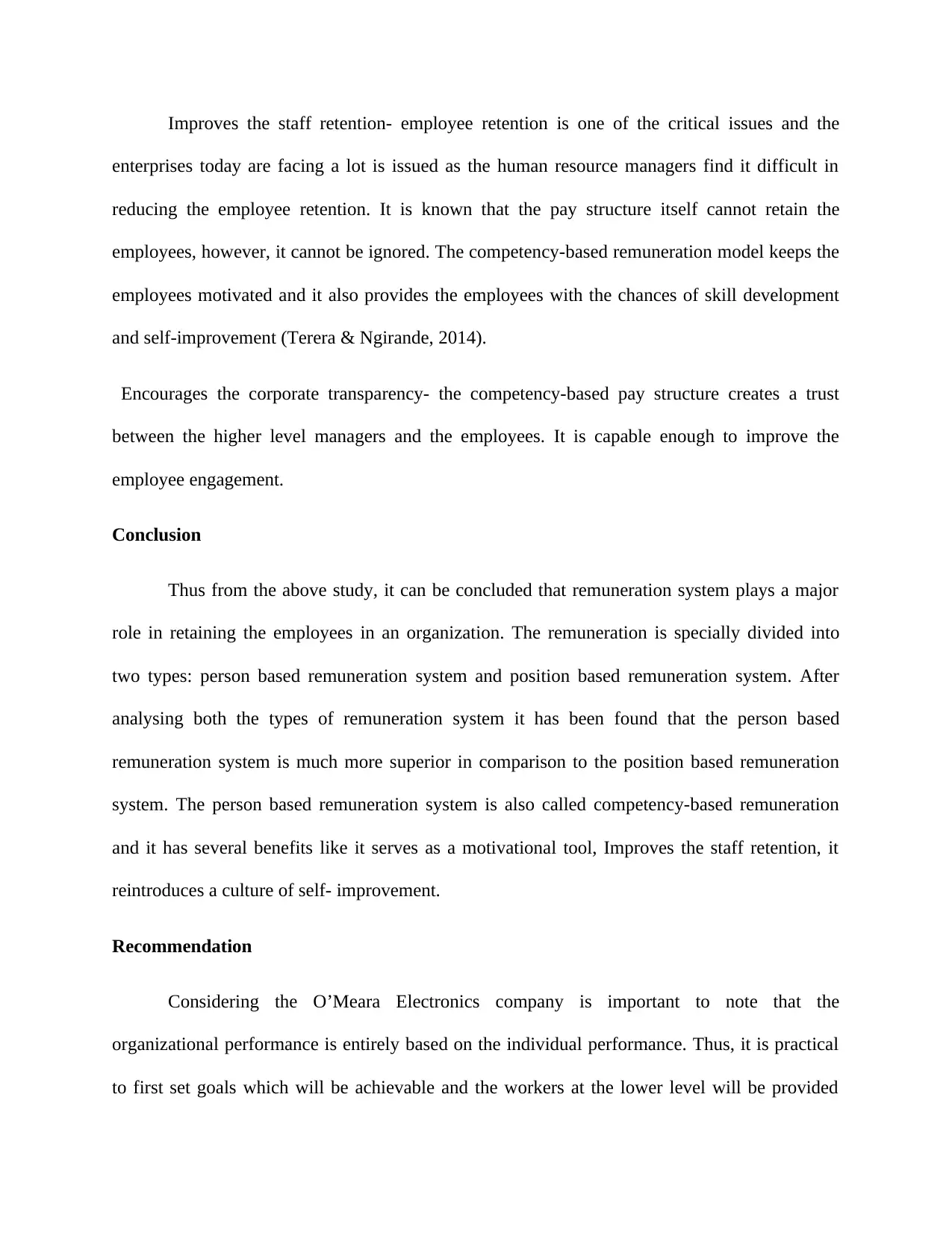
Improves the staff retention- employee retention is one of the critical issues and the
enterprises today are facing a lot is issued as the human resource managers find it difficult in
reducing the employee retention. It is known that the pay structure itself cannot retain the
employees, however, it cannot be ignored. The competency-based remuneration model keeps the
employees motivated and it also provides the employees with the chances of skill development
and self-improvement (Terera & Ngirande, 2014).
Encourages the corporate transparency- the competency-based pay structure creates a trust
between the higher level managers and the employees. It is capable enough to improve the
employee engagement.
Conclusion
Thus from the above study, it can be concluded that remuneration system plays a major
role in retaining the employees in an organization. The remuneration is specially divided into
two types: person based remuneration system and position based remuneration system. After
analysing both the types of remuneration system it has been found that the person based
remuneration system is much more superior in comparison to the position based remuneration
system. The person based remuneration system is also called competency-based remuneration
and it has several benefits like it serves as a motivational tool, Improves the staff retention, it
reintroduces a culture of self- improvement.
Recommendation
Considering the O’Meara Electronics company is important to note that the
organizational performance is entirely based on the individual performance. Thus, it is practical
to first set goals which will be achievable and the workers at the lower level will be provided
enterprises today are facing a lot is issued as the human resource managers find it difficult in
reducing the employee retention. It is known that the pay structure itself cannot retain the
employees, however, it cannot be ignored. The competency-based remuneration model keeps the
employees motivated and it also provides the employees with the chances of skill development
and self-improvement (Terera & Ngirande, 2014).
Encourages the corporate transparency- the competency-based pay structure creates a trust
between the higher level managers and the employees. It is capable enough to improve the
employee engagement.
Conclusion
Thus from the above study, it can be concluded that remuneration system plays a major
role in retaining the employees in an organization. The remuneration is specially divided into
two types: person based remuneration system and position based remuneration system. After
analysing both the types of remuneration system it has been found that the person based
remuneration system is much more superior in comparison to the position based remuneration
system. The person based remuneration system is also called competency-based remuneration
and it has several benefits like it serves as a motivational tool, Improves the staff retention, it
reintroduces a culture of self- improvement.
Recommendation
Considering the O’Meara Electronics company is important to note that the
organizational performance is entirely based on the individual performance. Thus, it is practical
to first set goals which will be achievable and the workers at the lower level will be provided
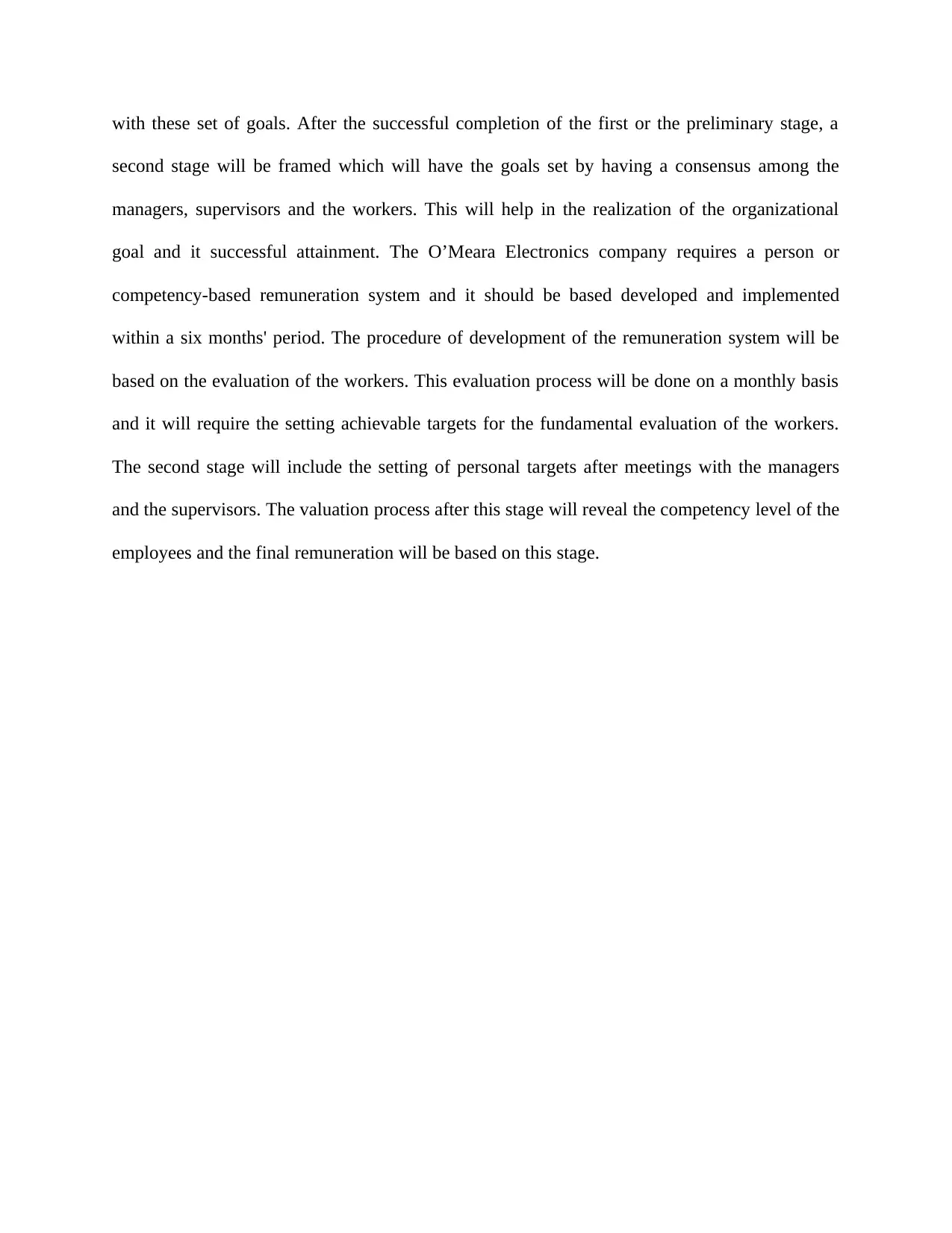
with these set of goals. After the successful completion of the first or the preliminary stage, a
second stage will be framed which will have the goals set by having a consensus among the
managers, supervisors and the workers. This will help in the realization of the organizational
goal and it successful attainment. The O’Meara Electronics company requires a person or
competency-based remuneration system and it should be based developed and implemented
within a six months' period. The procedure of development of the remuneration system will be
based on the evaluation of the workers. This evaluation process will be done on a monthly basis
and it will require the setting achievable targets for the fundamental evaluation of the workers.
The second stage will include the setting of personal targets after meetings with the managers
and the supervisors. The valuation process after this stage will reveal the competency level of the
employees and the final remuneration will be based on this stage.
second stage will be framed which will have the goals set by having a consensus among the
managers, supervisors and the workers. This will help in the realization of the organizational
goal and it successful attainment. The O’Meara Electronics company requires a person or
competency-based remuneration system and it should be based developed and implemented
within a six months' period. The procedure of development of the remuneration system will be
based on the evaluation of the workers. This evaluation process will be done on a monthly basis
and it will require the setting achievable targets for the fundamental evaluation of the workers.
The second stage will include the setting of personal targets after meetings with the managers
and the supervisors. The valuation process after this stage will reveal the competency level of the
employees and the final remuneration will be based on this stage.
⊘ This is a preview!⊘
Do you want full access?
Subscribe today to unlock all pages.

Trusted by 1+ million students worldwide
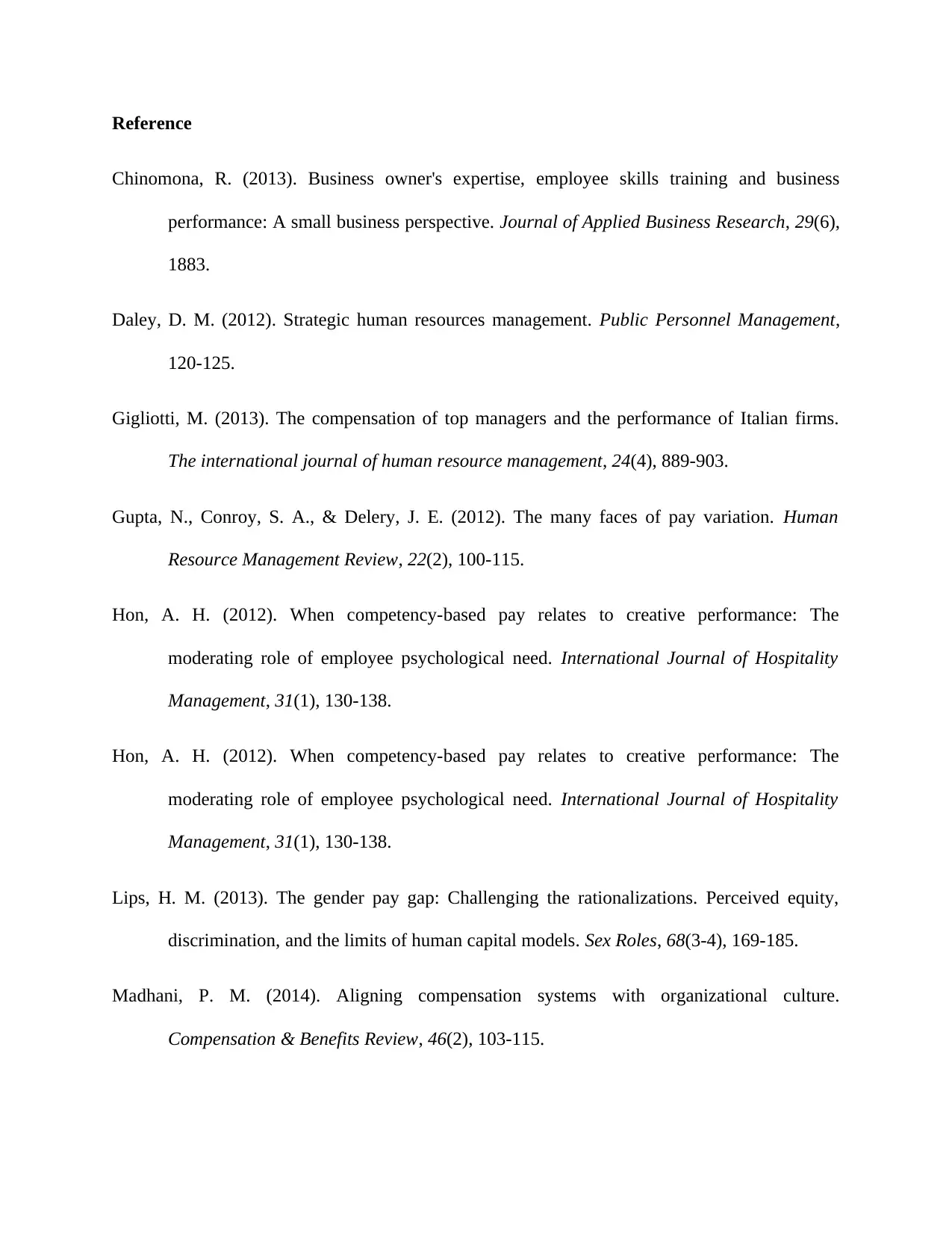
Reference
Chinomona, R. (2013). Business owner's expertise, employee skills training and business
performance: A small business perspective. Journal of Applied Business Research, 29(6),
1883.
Daley, D. M. (2012). Strategic human resources management. Public Personnel Management,
120-125.
Gigliotti, M. (2013). The compensation of top managers and the performance of Italian firms.
The international journal of human resource management, 24(4), 889-903.
Gupta, N., Conroy, S. A., & Delery, J. E. (2012). The many faces of pay variation. Human
Resource Management Review, 22(2), 100-115.
Hon, A. H. (2012). When competency-based pay relates to creative performance: The
moderating role of employee psychological need. International Journal of Hospitality
Management, 31(1), 130-138.
Hon, A. H. (2012). When competency-based pay relates to creative performance: The
moderating role of employee psychological need. International Journal of Hospitality
Management, 31(1), 130-138.
Lips, H. M. (2013). The gender pay gap: Challenging the rationalizations. Perceived equity,
discrimination, and the limits of human capital models. Sex Roles, 68(3-4), 169-185.
Madhani, P. M. (2014). Aligning compensation systems with organizational culture.
Compensation & Benefits Review, 46(2), 103-115.
Chinomona, R. (2013). Business owner's expertise, employee skills training and business
performance: A small business perspective. Journal of Applied Business Research, 29(6),
1883.
Daley, D. M. (2012). Strategic human resources management. Public Personnel Management,
120-125.
Gigliotti, M. (2013). The compensation of top managers and the performance of Italian firms.
The international journal of human resource management, 24(4), 889-903.
Gupta, N., Conroy, S. A., & Delery, J. E. (2012). The many faces of pay variation. Human
Resource Management Review, 22(2), 100-115.
Hon, A. H. (2012). When competency-based pay relates to creative performance: The
moderating role of employee psychological need. International Journal of Hospitality
Management, 31(1), 130-138.
Hon, A. H. (2012). When competency-based pay relates to creative performance: The
moderating role of employee psychological need. International Journal of Hospitality
Management, 31(1), 130-138.
Lips, H. M. (2013). The gender pay gap: Challenging the rationalizations. Perceived equity,
discrimination, and the limits of human capital models. Sex Roles, 68(3-4), 169-185.
Madhani, P. M. (2014). Aligning compensation systems with organizational culture.
Compensation & Benefits Review, 46(2), 103-115.
Paraphrase This Document
Need a fresh take? Get an instant paraphrase of this document with our AI Paraphraser
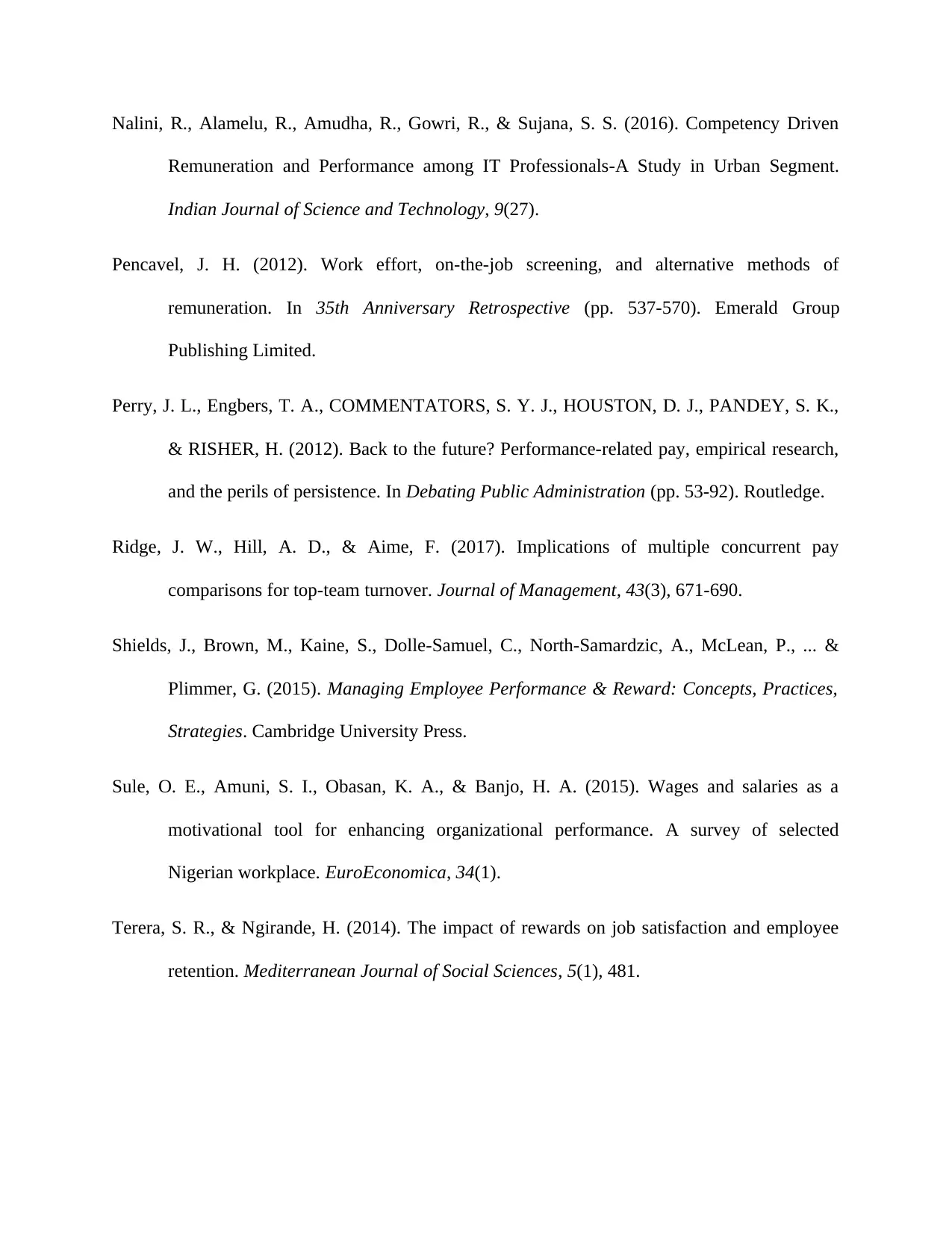
Nalini, R., Alamelu, R., Amudha, R., Gowri, R., & Sujana, S. S. (2016). Competency Driven
Remuneration and Performance among IT Professionals-A Study in Urban Segment.
Indian Journal of Science and Technology, 9(27).
Pencavel, J. H. (2012). Work effort, on-the-job screening, and alternative methods of
remuneration. In 35th Anniversary Retrospective (pp. 537-570). Emerald Group
Publishing Limited.
Perry, J. L., Engbers, T. A., COMMENTATORS, S. Y. J., HOUSTON, D. J., PANDEY, S. K.,
& RISHER, H. (2012). Back to the future? Performance-related pay, empirical research,
and the perils of persistence. In Debating Public Administration (pp. 53-92). Routledge.
Ridge, J. W., Hill, A. D., & Aime, F. (2017). Implications of multiple concurrent pay
comparisons for top-team turnover. Journal of Management, 43(3), 671-690.
Shields, J., Brown, M., Kaine, S., Dolle-Samuel, C., North-Samardzic, A., McLean, P., ... &
Plimmer, G. (2015). Managing Employee Performance & Reward: Concepts, Practices,
Strategies. Cambridge University Press.
Sule, O. E., Amuni, S. I., Obasan, K. A., & Banjo, H. A. (2015). Wages and salaries as a
motivational tool for enhancing organizational performance. A survey of selected
Nigerian workplace. EuroEconomica, 34(1).
Terera, S. R., & Ngirande, H. (2014). The impact of rewards on job satisfaction and employee
retention. Mediterranean Journal of Social Sciences, 5(1), 481.
Remuneration and Performance among IT Professionals-A Study in Urban Segment.
Indian Journal of Science and Technology, 9(27).
Pencavel, J. H. (2012). Work effort, on-the-job screening, and alternative methods of
remuneration. In 35th Anniversary Retrospective (pp. 537-570). Emerald Group
Publishing Limited.
Perry, J. L., Engbers, T. A., COMMENTATORS, S. Y. J., HOUSTON, D. J., PANDEY, S. K.,
& RISHER, H. (2012). Back to the future? Performance-related pay, empirical research,
and the perils of persistence. In Debating Public Administration (pp. 53-92). Routledge.
Ridge, J. W., Hill, A. D., & Aime, F. (2017). Implications of multiple concurrent pay
comparisons for top-team turnover. Journal of Management, 43(3), 671-690.
Shields, J., Brown, M., Kaine, S., Dolle-Samuel, C., North-Samardzic, A., McLean, P., ... &
Plimmer, G. (2015). Managing Employee Performance & Reward: Concepts, Practices,
Strategies. Cambridge University Press.
Sule, O. E., Amuni, S. I., Obasan, K. A., & Banjo, H. A. (2015). Wages and salaries as a
motivational tool for enhancing organizational performance. A survey of selected
Nigerian workplace. EuroEconomica, 34(1).
Terera, S. R., & Ngirande, H. (2014). The impact of rewards on job satisfaction and employee
retention. Mediterranean Journal of Social Sciences, 5(1), 481.

Urbancová, H., & Šnýdrová, M. (2017). Remuneration and Employee Benefits in Organizations
in the Czech Republic. Acta Universitatis Agriculturae et Silviculturae Mendelianae
Brunensis, 65(1), 357-368.
in the Czech Republic. Acta Universitatis Agriculturae et Silviculturae Mendelianae
Brunensis, 65(1), 357-368.
⊘ This is a preview!⊘
Do you want full access?
Subscribe today to unlock all pages.

Trusted by 1+ million students worldwide
1 out of 12
Related Documents
Your All-in-One AI-Powered Toolkit for Academic Success.
+13062052269
info@desklib.com
Available 24*7 on WhatsApp / Email
![[object Object]](/_next/static/media/star-bottom.7253800d.svg)
Unlock your academic potential
Copyright © 2020–2025 A2Z Services. All Rights Reserved. Developed and managed by ZUCOL.





